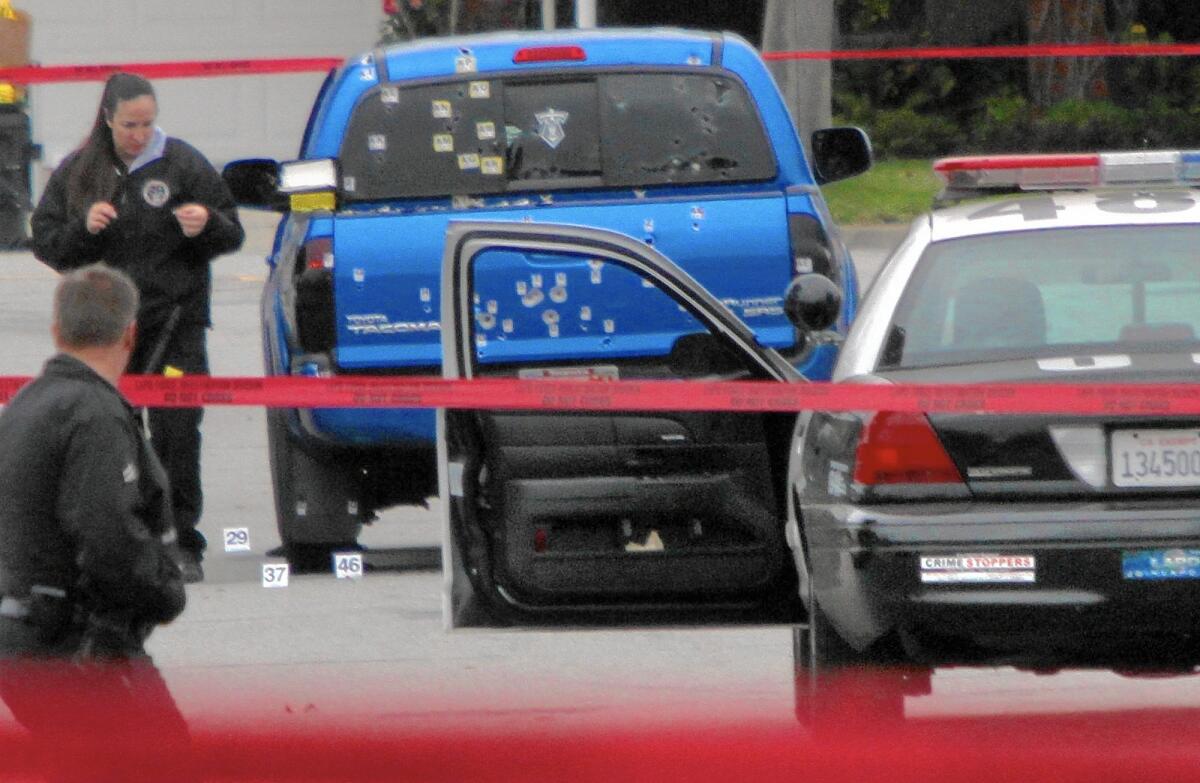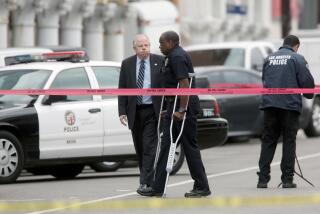No charges for LAPD officers in mistaken Dorner shooting; memo details how things went wrong

The Los Angeles police sergeant was worried.
He and a group of officers were responsible for protecting the Torrance home of a police captain believed to be a target of Christopher Dorner, a rogue former cop who was in the middle of a vengeful rampage against police and their families.
Sgt. Rudy Vidal had never been involved in a protective detail. He was concerned he didn’t have enough officers for the job. Armed with only shotguns and handguns, he feared they would be outgunned by Dorner, who had bragged about having access to sniper rifles and surface-to-air missiles.
Vidal learned that Dorner had attacked officers in Riverside and Corona that night, killing one. The sergeant discussed with his officers how they’d react to the fugitive, depending on how many of them Dorner “doesn’t take out.”
The tense scene and chaotic moments that followed were described in detail in a memo released by the district attorney’s office Wednesday, when prosecutors announced they would not charge the officers who opened fire on two newspaper delivery women they mistook for Dorner.
The mother and daughter were in a blue Toyota Tacoma truck; the officers had been warned that Dorner was driving a blue or gray Nissan Titan pickup. A sergeant and seven officers stationed outside the home unleashed more than 100 rounds, mistakenly believing they were under fire.
The Feb. 7, 2013, shooting remains a controversial episode in the dramatic, days-long search for Dorner, who killed four people and wounded three others before dying in a gun battle with police.
The women received $4.2 million in a legal settlement from the city of Los Angeles, along with money to buy a new truck. The officers were faulted by LAPD Chief Charlie Beck and the Police Commission, and received weeks of extensive retraining before returning to the field.
“The barrage of gunfire was tremendous, and troubling,” prosecutors wrote, but not criminal.
“The fear of Dorner was understandable and justified,” the memo said. “There is no evidence to suggest that the officers did not honestly believe that Dorner was in the vehicle, nor is there evidence to suggest that the officers did not honestly believe they were being fired upon.”
Prosecutors emphasized, however, that their decision was “not an endorsement” of the officers’ actions or the LAPD’s tactical decisions. The officers’ judgment was “clouded” by heightened fears of Dorner, the memo said, which were compounded by limited planning, instruction and resources.
“The situation could not have been worse,” the memo read.
The LAPD declined to comment Wednesday.
One of the victims, Margie Carranza, told investigators the shooting was a “giant atrocity” and a “savage deed.” Carranza was cut on her hand as the hailstorm of bullets flew; her 71-year-old mother, Emma Hernandez, was struck twice in the back.
Their attorney, Glen Jonas, criticized the district attorney’s handling of the case, saying a special prosecutor should have been appointed. Prosecutors, he noted, redacted key information from the 52-page memo that was made public, including statements from the officers who opened fire.
“I’m not looking to have people charged when they shouldn’t be charged,” he said. “But how do we have any faith in this decision based on the letter that we’re reading?”
A spokeswoman for the district attorney’s office said prosecutors could not release the compelled statements of officers who fire their weapons because those comments are part of their personnel records, which are confidential under state law.
Gary Fullerton, an attorney representing the officers, said the district attorney’s office made a “wise decision.” Fullerton blamed the shooting on a “big chain of mistakes” stemming from how top police brass handled the manhunt, saying the officers in Torrance didn’t have the proper equipment, training or information.
“They truly thought they were fighting Chris Dorner at that moment,” he said. “When they realized what they did, they all felt terrible.… But at the time that they did it, they felt absolutely that they had to do what they had to do.”
The president of the union that represents rank-and-file officers said police leaders hadn’t trained the officers to protect a high-profile target, yet the chief still faulted them for the shooting. The officers, Craig Lally said, “were put in a very bad position.”
Police across Southern California were on edge during the massive manhunt for Dorner, a former LAPD officer who alleged he was wrongly fired and was seeking revenge. The manhunt began after the daughter of a former LAPD captain and her fiance, a USC public safety officer, were found shot dead in their car in Irvine.
Investigators quickly discovered a 17-page manifesto that Dorner had posted online, vowing “unconventional and asymmetrical warfare” against officers and their families. He named specific LAPD personnel, including a captain who lived in Torrance.
The LAPD scrambled to deploy dozens of protective details across the region, warning officers and their families that they were at risk. In a 2014 report, Beck said there were 40 locations being protected at the time of the Torrance shooting — a number that grew to as many as 77 — stretching LAPD resources “well beyond normal deployment means.”
About 1:30 a.m. on Feb. 7 — just hours after police went public with their search for Dorner — the wanted former cop shot at two LAPD officers in Corona. About 10 minutes later, police say, he ambushed two Riverside officers stopped at a light, killing one.
Vidal learned of the Corona and Riverside shootings and warned his officers in Torrance to “be on high alert,” according to the memo from prosecutors. That night, the patrol officers had replaced a violent crime task force — “a seemingly more qualified team,” the memo said — that had been assigned earlier to protect the captain’s house.
Join the conversation on Facebook >>
The task force had more officers and was able to cover more ground, Vidal said.
At some point, Vidal was replaced by another sergeant and left the scene.
About 4:20 a.m., a woman called 911 about a light gray Nissan Titan — she believed it was Dorner’s — weaving across the 105 Freeway. The pickup was seen heading south on Sepulveda Boulevard — possibly toward Torrance, a lieutenant told the new sergeant on scene.
Less than an hour later, the officers saw a truck creep down the street, its headlights and hazards on. The officers thought the vehicle was Dorner’s. When one officer heard what he thought was a gunshot, the group opened fire.
The sound, however, had come from a newspaper hitting the ground.
As the officers unleashed a barrage of bullets, the captain they were assigned to protect flew out of his bed, the memo said. Believing Dorner was at his doorstep, Capt. Justin Eisenberg grabbed his gun and a flashlight and told his family to get on the ground.
Eisenberg, he recalled to investigators, aimed his gun at the door as his family prayed. During a lull in the shooting, he went to his garage to get a rifle. When he saw the bullet-riddled truck on the street, Eisenberg asked about Dorner.
“Where is the suspect?” he said.
“He’s not here,” an officer replied. “He’s not here.”
[email protected] | Twitter: @JosephSerna
[email protected] | Twitter: @katemather
ALSO
Three more arrests at Oregon refuge as some holdouts leave voluntarily
Alleged gang members arrested in O.C. jailbreak probe, but 3 escapees still at large
Good time turned ugly after teasing for Blake Griffin and Clippers assistant
More to Read
Sign up for Essential California
The most important California stories and recommendations in your inbox every morning.
You may occasionally receive promotional content from the Los Angeles Times.












